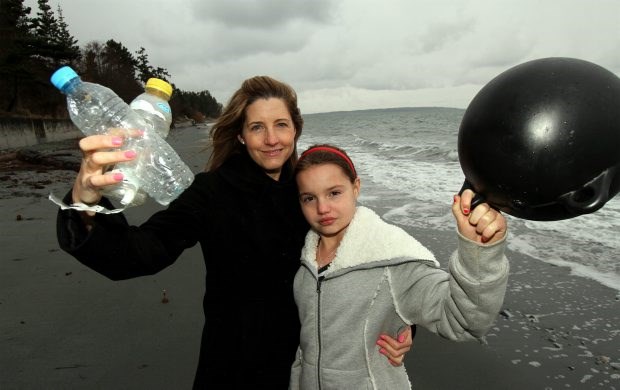Beth Hayhurst has walked the beaches near her Cordova Bay home almost every day for the past six years and has never seen so much debris - much of it with Asian markings - as in the past two months.
While Hayhurst, a photographer, cannot say with certainty that it is from the tsunami that hit Japan last March, she suspects it is and worries about local preparedness to deal with an anticipated wave of debris expected to wash up on North American shores by 2013.
"I feel very sombre and sad when I see the debris because of the suffering it represents," Hayhurst said. "But, speaking selfishly, it also makes me sad for what this beach might be in a year if we don't have a plan to clean it up."
Hayhurst and numerous other people on Vancouver Island, and along the coast of North America, have noticed what seems to be increasing amounts of Japanese debris.
Scientists doubt that the debris - everything from buoys to curtains to plastic bottles and coloured wood - is from the tsunami that swept tonnes of household items into the ocean. But they are cataloguing significant sightings.
Both the National Oceanic and Atmospheric Administration (NOAA) and the University of Hawaii have made computerized models of the debris.
Both models estimate that debris could wash ashore the west coast of North America by early next year.
NOAA's marine debris division recently set up a website for reported significant debris sightings - disasterdebris.noaa.gov. So far, about 30 reports, from B.C. to California, have come in, NOAA communications officer Dianna Parker said.
The increase in reports of suspected tsunami debris could be due to heightened awareness, although some of the lighter buoys, which can travel faster over water, might be from the tsunami, Parker said.
So far, there have been only two confirmed sightings of debris, both small fishing vessels, she said.
One was found by a Russian research vessel, northwest of the Hawaiian Islands in September, and another in July, closer to Japan. Both were from Fukushima.
"It is incredibly difficult to fingerprint pieces back to the tsunami," Parker said.
Marine debris washes ashore every day, including that with Japanese markings on them from ships at sea, she said.
NOAA and the University of Hawaii initially tracked the tsunami debris field via low resolution satellites. After April 14, the satellites could no longer pick up the field, which started to break up.
Although there have been reports of a debris field as large as 20 million tonnes, Parker said that is misleading. In total, between 20 to 25 million tonnes of debris were pushed out to sea by the tsunami. Just how much sank near shore and how much was pushed out to sea is not definitive, she said.
Whether it is 20 million tonnes or half that, it is still going to present a problem on local shores where debris is an aberration from the norm. Hayhurst has found a lot of debris on Sayward Beach since the end of November. Usually, the beach, which has many nooks and crannies, picks up little garbage. The coloured planks of wood, large chunks of Styrofoam, curtains attached to wooden rods, sheets of insulation and smaller things like juice and water bottles - many with Asian markings - are new to the beach, Hayhurst said.
"I've never seen a bottle on the beach from anywhere other than Canada before."
Hayhurst has documented items she has found. They are on her blog, bethhayhurstblog.com/ unusual-beach-debris/.
B.C. has created a provincial tsunami debris co-ordinating committee.
Its members are to selected by next week.
kwestad@timescolonist.com
> The National Oceanic and Atmospheric Administration computerized model can be viewed at marinedebris.noaa.gov/info/ japanfaqs.html.



